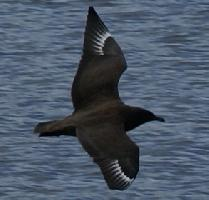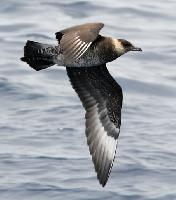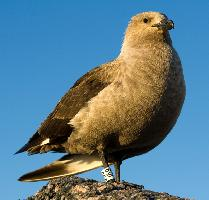
Description de l'animal
The Great Skua, scientifically known as Stercorarius skua, is a formidable and majestic seabird that commands attention with its powerful presence. This bird is the largest of the skua family, with a robust build that is perfectly adapted to its lifestyle in the harsh environments of the North Atlantic and the subarctic regions where it primarily resides.Characterized by its impressive size, the Great Skua typically measures between 50 to 58 cm in length, with a wingspan that can stretch from 125 to 140 cm. This bird is easily recognized by its dark brown plumage, which may appear almost black in certain lights, and the white wing patches that become visible during flight. These patches are a key distinguishing feature, especially when observed from a distance. The bird's head is robust, with a strong, hooked beak that is perfectly designed for its predatory lifestyle. Its eyes are sharp, reflecting a keen intelligence and an adept hunting ability.
Great Skuas are formidable predators and scavengers, showcasing a diverse diet that includes fish, small birds, and carrion. They are known for their aggressive behavior, especially when hunting or defending their territory. These birds are not afraid to challenge other birds, including larger species, often engaging in dramatic aerial pursuits to rob them of their catch, a behavior known as kleptoparasitism. This fearless nature extends to their nesting habits, as they vigorously defend their nests against any perceived threats.
Breeding mainly on remote islands in the North Atlantic, such as the Shetland and Orkney islands, the Great Skua prefers open ground for nesting. Their nests are relatively simple, often just a scrape in the ground lined with vegetation and feathers. During the breeding season, these birds exhibit strong pair bonds and are known for their loud, raucous calls that echo across their breeding territories.
Despite their aggressive nature, Great Skuas are also known for their long migratory journeys. Outside the breeding season, they travel widely across the Atlantic, with some individuals reaching as far south as the coasts of South America and Africa. These migrations are a testament to the bird's resilience and adaptability in the face of the vast and unpredictable ocean environment.
Conservation-wise, the Great Skua is currently classified as Least Concern by the International Union for Conservation of Nature (IUCN), though it faces threats from pollution, climate change, and changes in fish populations. Conservation efforts focus on protecting their breeding sites and monitoring population trends to ensure that these magnificent birds continue to thrive in their natural habitats.
In summary, the Great Skua is a bird of contrasts—aggressive yet protective, formidable yet vulnerable to environmental changes. Its presence in the northern seas is a powerful reminder of nature's resilience and complexity.
Animaux similaires
Nouvelles photos d'animaux
Top 10 des animaux
- Dolphin gull (Leucophaeus scoresbii)
- Japanese macaque (Macaca fuscata)
- Stone loach (Barbatula barbatula)
- Greek tortoise (Testudo graeca)
- Russian tortoise (Testudo horsfieldii)
- Galápagos tortoise (Geochelone nigra complex)
- Diana monkey (Cercopithecus diana)
- Moustached guenon (Cercopithecus cephus)
- Common flying dragon (Draco volans)
- Galápagos penguin (Spheniscus mendiculus)


